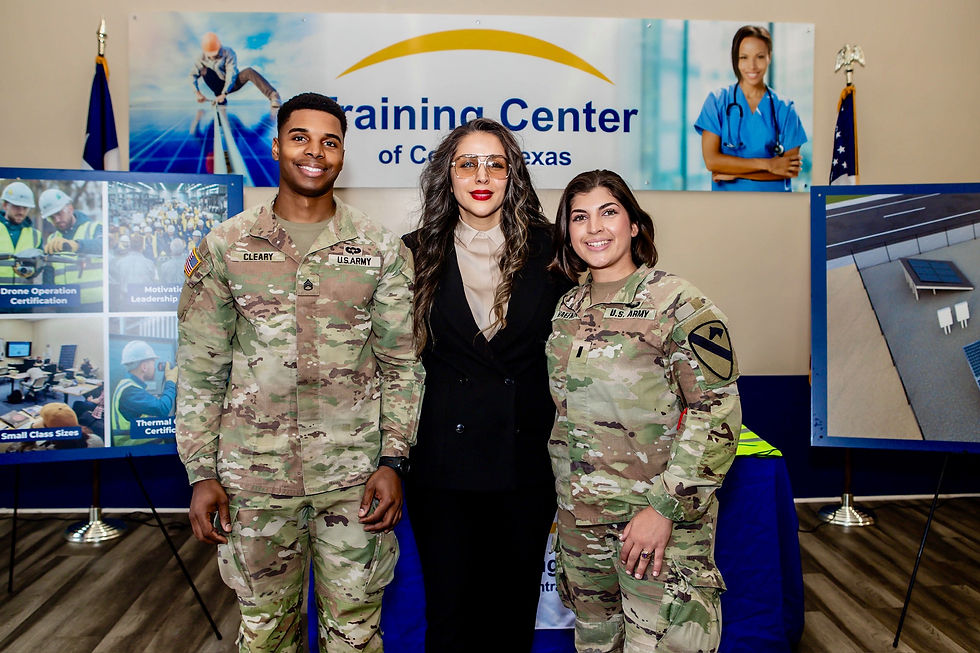Deep Research, Fast Learning—A New Chapter in CMA-AI’s AI Education
- Saran Lotfollahzadeh

- Apr 21
- 2 min read

From Hours of Searching to Minutes of Insight
Back in my early research days, literature reviews meant one thing: time. Hours spent scrolling through PubMed, sifting through irrelevant abstracts, and second-guessing every keyword. As a physician-scientist, I accepted this as part of the job. However, it wasn’t efficient—and it certainly wasn’t where the real learning happened.
That changed with AI. Alternatively, more accurately, it changed when Deep Research capabilities became accessible to us.
At The Training Center of Central Texas, we are teaching students not just to use AI—but to use it responsibly and strategically.
Introducing Deep Research: AI with Depth
AI tools like ChatGPT changed the game with their ease of use, but early versions had clear limitations—outdated training data and a lack of real-time, validated insight. That is where Deep Research enters the picture.
Unlike passive querying, Deep Research allows AI to:
Actively scan current data across trusted sources
Synthesize findings in minutes
Compare results with uploaded files and ongoing work
This is not just summarizing. It is searching with purpose—and teaching our students how to instruct AI to do the heavy lifting without losing critical thinking.
From the Lab to the Classroom: Why It Matters
Let’s say a student is preparing a presentation on chronic kidney disease. Instead of spending hours clicking through outdated links and abstracts, they now:
Feed the system keywords and parameters
Upload a few relevant PDFs
Get a structured, citation-backed overview within minutes
They still fact-check—because we train them to. Now, they are spending time on what actually matters: analyzing, thinking, learning.
Tools We Trust, Habits We Teach
As someone who’s used AI tools before ChatGPT and still approaches them cautiously, I share this with our students: Always double-check your sources.
AI is a tool, not a replacement for expertise. But when used properly, it frees up the one thing none of us have enough of—time.
Therefore, in our The Training Center of Central Texas CMA-AI curriculum, we are now incorporating:
Deep Research modules
Use-case labs comparing traditional vs. AI-assisted review
Practical AI prompts for literature synthesis
Because learning to ask better questions is what creates better clinicians.
Conclusion: AI Doesn’t Replace You—It Elevates You
Our students are being trained to interact with AI the same way a skilled researcher interacts with a microscope—not to blindly accept what they see, but to know how to direct the lens and interpret what comes through.
The future of healthcare education does not just belong to those who can memorize facts. It belongs to those who know how to navigate information wisely.
At The Training Center of Central Texas CMA-AI, we are building that wisdom into every module.
By Saran Lotfollahzadeh, MD, MSCR Candidate
MD, General Surgeon, Pediatric Surgery Sub-Specialist
MSCR Candidate
AHA Cardio-Oncology SFRN Fellow
Medical Director, CMA-AI Training Center of Central Texas
Instructor in Medicine



This is such an insightful perspective on the role of AI in healthcare education. The analogy of AI as a microscope is compelling—it’s not just about having access to information, but about knowing how to focus, interpret, and use it to inform decisions. As healthcare becomes more data-driven, the ability to navigate information wisely will be one of the most critical skills healthcare professionals can possess. Your approach at The Training Center of Central Texas CMA-AI is precisely what the future of education needs—empowering students not to receive information passively, but to engage with it actively, question it, and use it to elevate their practice. This mindset will improve patient care and shape a generation of healthcare professionals who are…
Absolutely love this perspective—and it couldn’t be more timely. As a physician-scientist, I remember the grind of manual lit reviews all too well—tedious hours that often left little room for actual analysis and innovation. The shift toward strategic AI integration, like your Deep Research approach, is more than just a time-saver—it’s a mindset shift.
Teaching students how to instruct AI rather than just use it passively is the kind of critical thinking we need in modern clinical education. It’s not about shortcuts—it’s about smart, ethical acceleration. Excited to see how your curriculum shapes the next generation of clinician-researchers! 👏🧠
The Training Center of Central Texas is clearly setting a gold standard in workforce development for the solar energy sector. Hands-on experience with cutting-edge equipment like the Sungrow 3600UD and 4400 inverters doesn’t just prepare students—it launches them into a high-demand industry with confidence and real-world skills.
I’m especially impressed by the emphasis on full-cycle operational training and the strategic focus on Sungrow technology, which dominates the U.S. utility-scale solar market. That’s forward-thinking education with immediate impact. 🌞⚡
This kind of immersive, practical training is exactly what the renewable energy industry needs—and it’s changing lives in the process. Major kudos to your team for building not just a curriculum, but a future-ready workforce. 💪🔧🌍